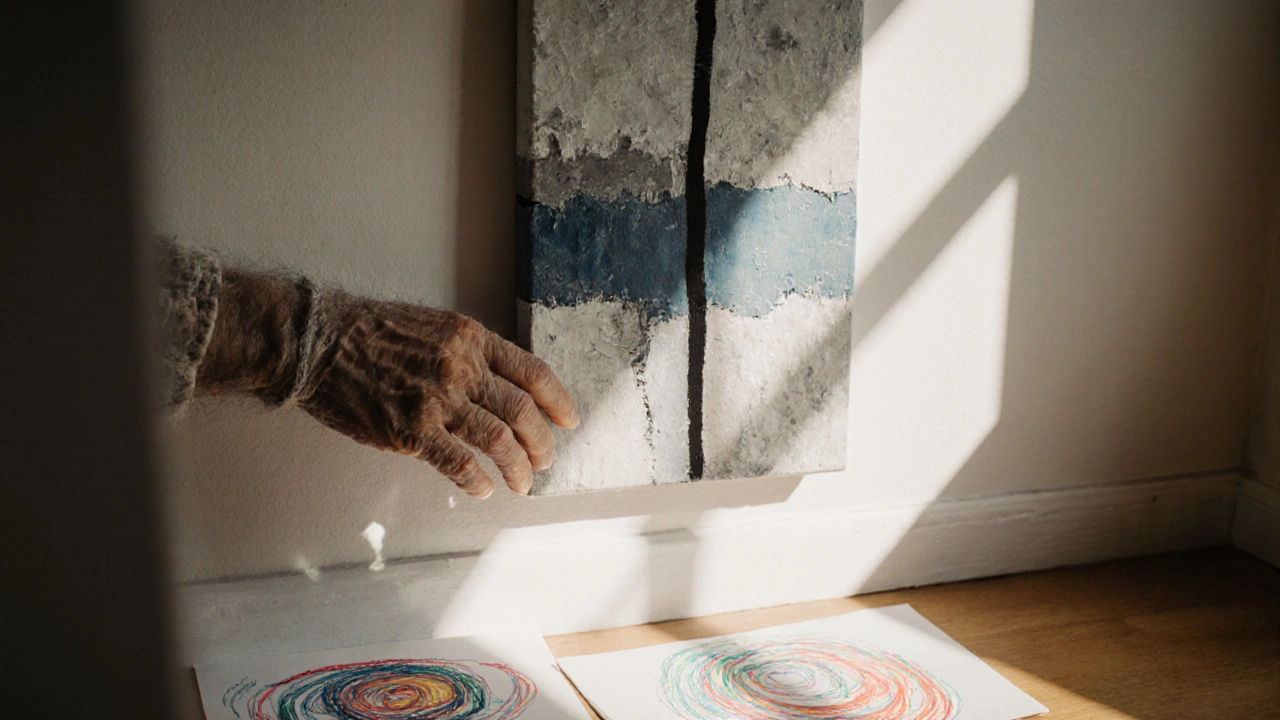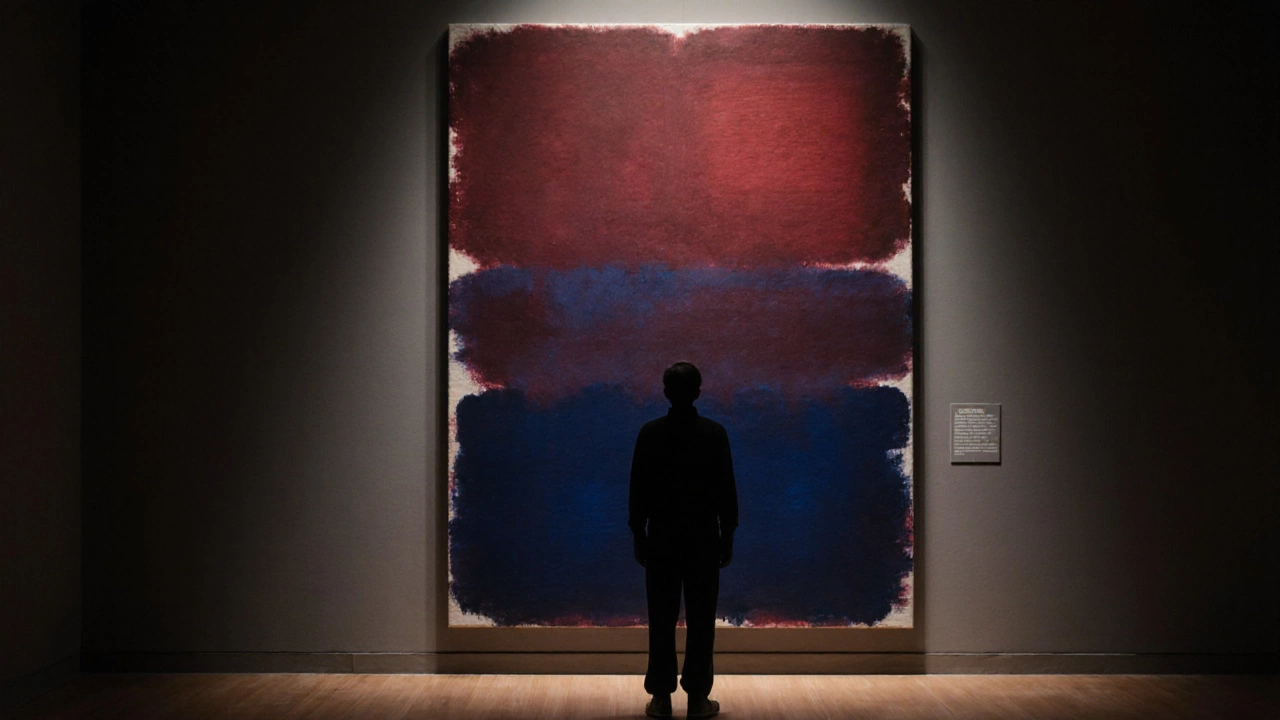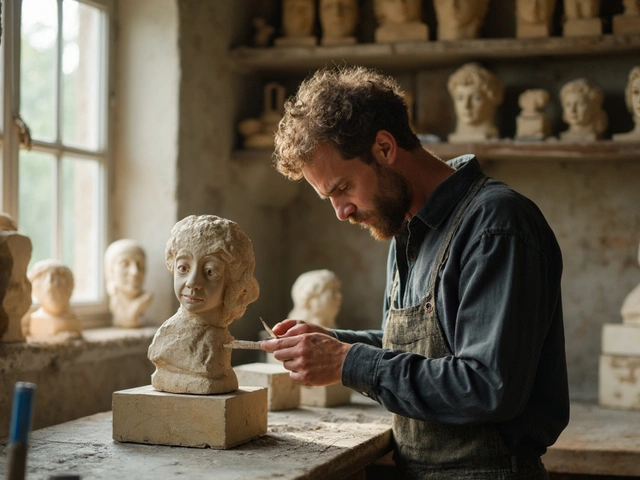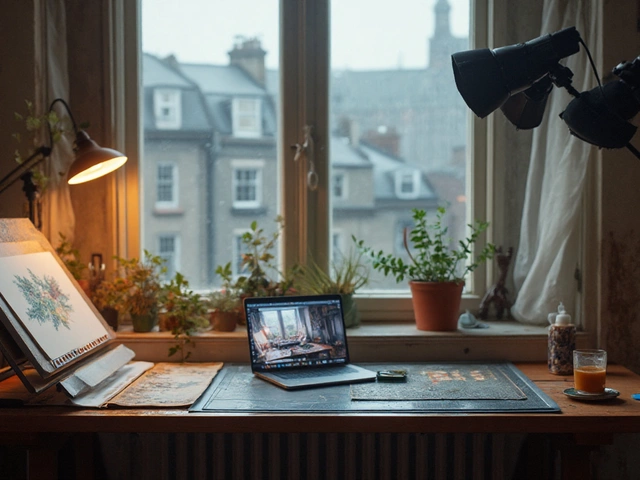Why do people stand in front of a canvas splattered with color, swirling lines, and shapes that don’t look like anything real-and feel something deep? It’s not about recognizing a tree or a face. It’s not about technical skill alone. Abstract art doesn’t explain itself. And yet, millions of people connect with it. Not because they understand it, but because it lets them feel something they can’t name.
It speaks when words fail
Abstract art doesn’t tell stories the way a portrait or a landscape does. It doesn’t say, ‘This is a woman crying’ or ‘This is a storm at sea.’ Instead, it creates space for the viewer’s own emotions to take over. A jagged red slash might feel like anger. A soft blue wash might feel like grief. A cluster of dots might feel like loneliness. You don’t need to know the artist’s intent. You just need to be open to what your own mind and body respond to.Studies from the University of London in 2023 showed that viewers of abstract art experienced stronger emotional activation in the amygdala-the brain’s emotional center-than those viewing representational art. Not because the abstract pieces were ‘better,’ but because they left room for personal meaning. The brain fills in the gaps. That’s why two people can look at the same Jackson Pollock and walk away with completely different stories.
Freedom from the rules
For centuries, art was about mastering realism. If you couldn’t draw a perfect hand or make a sky look like the real one, you weren’t considered skilled. Abstract art broke that. It said: what if color, texture, and movement alone could carry meaning? What if the artist didn’t need to copy the world to express something true about it?This freedom pulled in people who felt trapped by traditional art’s expectations. It attracted those who’d been told their feelings were ‘too messy’ or ‘not logical.’ Abstract art didn’t ask them to conform. It welcomed chaos, emotion, and intuition. That’s why it became so powerful for movements like Expressionism and later, for people dealing with trauma, mental health, or identity. Art became a way to show what couldn’t be spoken.
It’s a mirror, not a window
Most art shows you something outside yourself. Abstract art turns the gaze inward. When you look at a Mark Rothko painting-a large field of floating color-you’re not looking at a scene. You’re looking at how you feel in that space. The colors vibrate. The edges blur. Your breathing slows. Your thoughts quiet. You’re not observing art. You’re experiencing it.That’s why people return to abstract pieces again and again. They don’t get ‘solved.’ They change with you. A painting that felt calm in your twenties might feel heavy in your forties. That’s not a flaw. That’s the point. Abstract art doesn’t demand to be understood. It asks to be felt. And that’s rare in a world that values quick answers and clear meanings.

It challenges the idea of skill
Some people dismiss abstract art as ‘my kid could do that.’ But that misses the point. It’s not about technical precision. It’s about intention. A child’s scribble is random. An abstract artist’s mark is chosen. Every drip, every brushstroke, every layer is a decision made after years of experimentation, failure, and refinement.Wassily Kandinsky spent over a decade studying color theory and music before he made his first fully abstract piece. Hilma af Klint painted her abstract works in secret for years, guided by spiritual beliefs and mathematical patterns. These weren’t accidents. They were deeply considered acts of communication.
The skill isn’t in drawing a realistic tree. It’s in knowing how to make a single line feel like tension, or a smear of gray feel like silence. That takes discipline. That takes courage. And that’s why people who’ve studied art for years often feel more moved by abstract pieces than by technically perfect ones.
It connects to the unseen
Many abstract artists weren’t just painting colors. They were trying to express things science couldn’t yet measure: energy, emotion, spirituality, time. Kandinsky believed color had a sound. Rothko wanted his paintings to feel like religious experiences. Agnes Martin’s grids weren’t decorative-they were meditations on peace.These artists weren’t trying to show you what the world looks like. They were trying to show you what it feels like to be alive inside it. And that’s why people who feel disconnected from religion, politics, or even language still find meaning in abstract art. It doesn’t preach. It doesn’t argue. It simply exists-and invites you to exist with it.

It’s personal, not universal
There’s no single reason why abstract art moves people. For some, it’s nostalgia. A swirl of color reminds them of a childhood bedroom wall. For others, it’s rebellion. It’s the art they chose when they were rejecting everything their parents valued. For some, it’s comfort. In a world full of noise, a quiet Rothko feels like a deep breath.That’s the magic of abstract art. It doesn’t force one meaning. It holds space for many. You don’t need an art degree to feel it. You don’t need to know the artist’s name. You just need to be willing to sit with the feeling it brings up-even if you don’t know why.
It’s not about seeing. It’s about sensing.
We’re trained to think of art as something you analyze. Abstract art asks you to do something different: to sense it. To let your body react before your mind catches up. Your heart races. Your shoulders drop. You lean in. You step back. You don’t know why. And that’s okay.That’s why abstract art survives. It doesn’t need to be explained. It doesn’t need to be liked. It just needs to be felt. And in a world that’s always asking us to justify our emotions, that’s a quiet kind of revolution.
Why do people say abstract art is ‘just random’?
People say that because they’re used to art that represents something real. When they see a canvas with no recognizable object, their brain tries to find a pattern and fails. So they assume it’s random. But abstract art is rarely random. It’s intentional. Every mark is chosen after trial, error, and deep thought. Artists like Agnes Martin spent years perfecting a single line. The randomness is an illusion. The control is hidden.
Can anyone create meaningful abstract art?
Yes-but not by accident. Anyone can smear paint on a canvas. But meaningful abstract art comes from intention, repetition, and emotional honesty. It’s not about skill in drawing, but in knowing how to use color, texture, and space to evoke feeling. Many people find their voice in abstraction because it doesn’t require technical perfection. It requires courage to be vulnerable.
Is abstract art just for the elite?
No. While museums and galleries often display it, the emotional response to abstract art isn’t tied to education or wealth. People from all backgrounds connect with it in private spaces-on their walls, in their homes, even in children’s drawings. The myth that it’s only for ‘experts’ was created by critics and dealers, not by the people who feel it. The most powerful abstract pieces often come from artists who had no formal training.
Why do some abstract paintings sell for millions?
Because they carry cultural weight, historical significance, and emotional depth that’s rare. A Willem de Kooning or a Mark Rothko doesn’t just sell for its paint and canvas. It sells for the decades of work behind it, the emotional impact it’s had on viewers, and its role in changing how we think about art. It’s not a commodity-it’s a landmark in how humans express inner experience.
Do I need to like abstract art to understand it?
No. You don’t need to like it to understand why it matters. Just as you don’t need to love jazz to understand its influence on music, you don’t need to enjoy abstract art to recognize its power. The point isn’t personal taste. It’s about recognizing that art can exist beyond representation-and that’s a profound shift in human expression.
If you’ve ever stood in front of an abstract painting and felt something you couldn’t explain-you already get it. You don’t need a lecture. You don’t need a guidebook. You just need to let yourself feel it. That’s the whole point.





